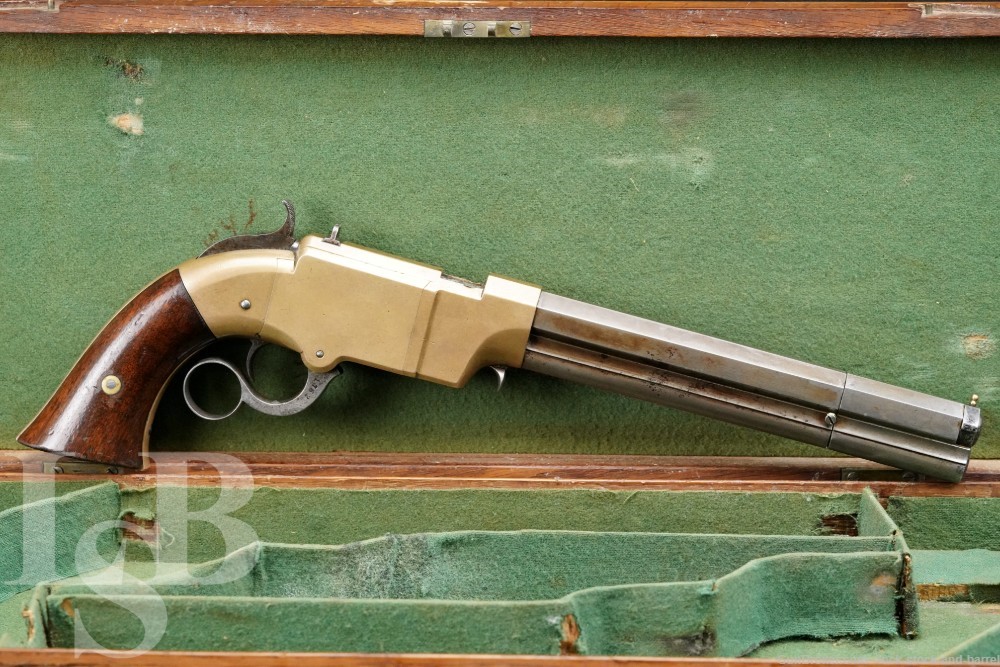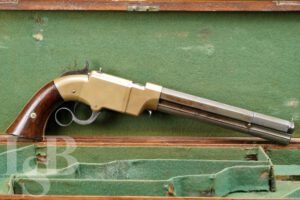
Volcanic Repeating Arms Co. Navy Holster Model .41 Rocket Ball Pistol, 1856
SOLD FOR: $9000
LSB#: 230509SH001
Make: Volcanic Repeating Arms Company
Model: Navy “Holster” Model
Serial Number: 1762
Year of Manufacture: Ca. 1856
Caliber: No. 2, .41 Caliber Rocket-Ball
Action Type: Lever-Action, Tubular Magazine Fed, Cartridge Firing Handgun
Markings: The top of the barrel is marked “THE VOLCANIC / REPEATING ARMS CO. / PATENT NEW HAVEN CONN FEB. 14. 1854”. The right of the frame under the right grip panel is marked “1762”. The inside of each grip panel is stamped “1762”. The right of the lever is marked “1762”, the left is marked “Y”.
Barrel Length: 8”
Sights / Optics: The front sight is a brass bead fixed to the top-front of the magazine sleeve’s front band. The rear sight is a “V”-notch dovetailed to the top-rear of the frame.
Stock Configuration & Condition: The grips are two-piece smooth walnut. The grips have light handling wear with some scattered nicks, scratches and spots of thinning finish. There is a tiny loss at the bottom-front corner of the right panel. There are no cracks. Overall, the grips are in Fine condition as Antique.
Type of Finish: Blue & Brass
Finish Originality: The barrel and magazine assembly show signs of cleaning and treatment with cold-blue in the distant past. The frame and other components are Original.
Bore Condition: The bore is semi-bright with sharp rifling. There are scattered spots of erosion and pitting in the bore. In this writer’s opinion, the bore rates 6 or 7 out of 10.
Overall Condition: This pistol retains about 60% of its metal finish. The barrel and magazine assembly has mostly worn to white, showing some spots of erosion and treatment with cold blue in the distant past. The frame has gone to a fairly uniform mustard patina with some scattered nicks and small scratches. The lever and hammer’s exposed case color has mostly muted, but there is good color on the interior portion of the hammer, visible when cocked. The extractor is eroded, as is common for this model. The screw heads are tool marked with strong slots. The markings range from clear to worn, but legible. Overall, this handgun is in Fine condition as Antique.
Mechanics: Please note, this pistol is designed to be operated by first cocking the hammer, then operating the lever. The design is not intended to be operated using only the lever. The action functions correctly, however the extractor is eroded, as is common for this model. The hammer spring is strong, the trigger is crisp. As with all used firearms, a thorough cleaning may be necessary to meet your maintenance standards.
Box, Paperwork & Accessories: This pistol comes with a wood presentation case which is fit for two pistols (only one pistol is included).
Our Assessment: The Volcanic pistols and carbines are an incredibly important piece of American firearms history, being a part of the beginnings of both Smith & Wesson as well as Winchester. The original 1848 “Volition Repeating Rifle” design by Walter Hunt was revolutionary, introducing an early iteration of the lever action repeating mechanism and the tubular magazine still common today. However, Hunt’s design was far from perfect, and only a couple of prototypes were developed. Lewis Jennings patented an improved version of Hunt’s design in 1849, and versions of the Jenning’s patent design were built by Robbins & Lawrence Co. (under the direction of shop foreman Benjamin Tyler Henry) and sold by C. P. Dixon. Horace Smith was also hired by Courtlandt Palmer to improve the Jennings Rifle, patenting the Smith-Jennings in 1851.
By 1854, partners Horace Smith and Daniel B. Wesson along with Courtlandt Palmer and B. Tyler Henry, continued to further improve on the operating mechanism, developing the Smith & Wesson Lever pistol, and a new Volcanic cartridge. The new cartridge improved upon the Hunt Rocket Ball with the addition of a primer. Originally using the name “Smith & Wesson Company”, the name was changed to “Volcanic Repeating Arms Company” in 1855, with the addition of new investors, one of which was Oliver Winchester. The Volcanic Repeating Arms Company obtained all rights for the Volcanic designs (both rifle and pistol versions were in production by this time) as well as the ammunition, from the Smith and Wesson Company. Wesson remained as plant manager for 8 months before rejoining Smith to found the “Smith & Wesson Revolver Company” upon obtaining the licensing of the Rollin White rear loading cylinder patent.
Winchester forced the insolvency of the Volcanic Arms Company in late 1856, took over ownership and moved the plant to New Haven, Connecticut, where it was reorganized as the New Haven Arms Company in April 1857. B. Tyler Henry was hired as plant superintendent when Robbins & Lawrence suffered financial difficulties and Henry left their employ. While continuing to make the Volcanic rifle and pistol, Henry began to experiment with the new rimfire ammunition, and modified the Volcanic lever action design to use it. The result was the 1860 Henry rifle. By 1866, the company once again reorganized, this time as the Winchester Repeating Arms company, and the name of Winchester became synonymous with lever action rifles.
This is a great example of a rarely seen Volcanic Repeating Arms Navy Pistol. Its 8″ barrel makes it a “Holster” model where the 6″ examples were referred to as the “Belt” model. Only 3,000 repeaters were produced under the Volcanic Repeating Arms name, with about half being the Holster model. This pistol remains in nice condition and is a wonderful piece of American history. Please see our photos and good luck!
Please forgive any typos, I was educated in California. -Bud

